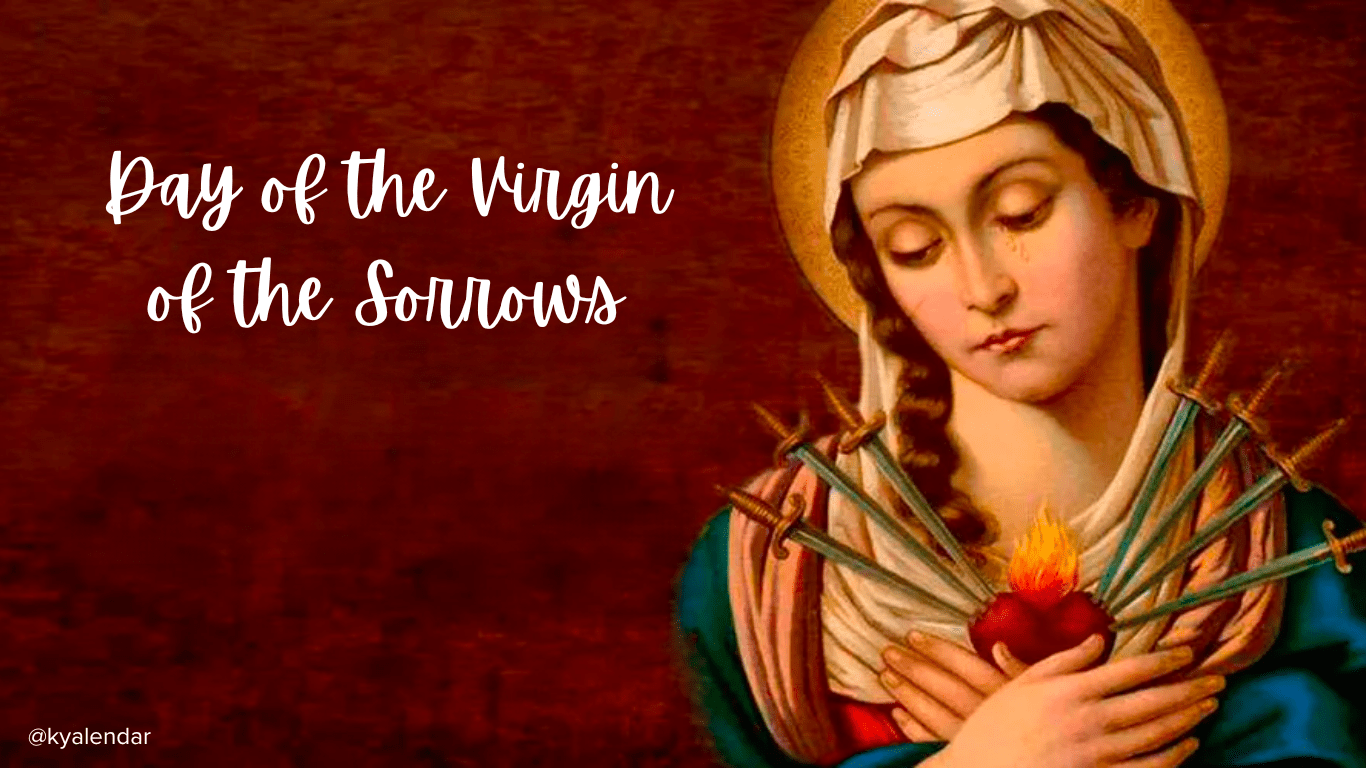
- This event has passed.
Day of the Virgin of the Sorrows
September 15

The Day of the Virgin of the Sorrows, also known as Our Lady of Sorrows, is a significant day in the Christian liturgical calendar dedicated to the veneration of the Virgin Mary under her title as “Our Lady of Sorrows”. This feast, observed on September 15, follows closely after the Feast of the Exaltation of the Holy Cross and serves as a poignant reflection on the suffering and sorrow experienced by Mary, the mother of Jesus.
Historical Background
The devotion to the Virgin of the Sorrows has roots in the early Christian tradition, where Mary’s suffering during the Passion of Christ was recognised and honoured. The formal establishment of the feast dedicated to Our Lady of Sorrows can be traced back to the 13th century. It gained prominence through the work of the Servite Order, a Catholic religious order founded in Florence, Italy, in 1233. The Servites were instrumental in promoting the devotion to the Seven Sorrows of Mary, which are key to the celebration of this feast.
The Seven Sorrows of Mary include:
- The prophecy of Simeon.
- The flight into Egypt.
- The loss of the child Jesus in the Temple.
- The meeting of Mary and Jesus on the way to Calvary.
- The crucifixion and death of Jesus.
- The body of Jesus being taken down from the cross and placed in Mary’s arms.
- The burial of Jesus.
Significance of the Day
The Day of the Virgin of the Sorrows is a time for Christians to reflect on the intense suffering and grief that Mary endured as the mother of Jesus. This day invites believers to empathise with Mary’s sorrows, recognising her profound role in the Passion and Crucifixion of Christ. It is a moment to honour her as a model of compassion, strength, and unwavering faith in the face of immense personal suffering.
The feast highlights Mary’s participation in Christ’s suffering and her role as a co-sufferer. It also serves as a reminder of the universal experience of suffering and the Christian call to find hope and solace in the midst of pain. The Virgin of the Sorrows is seen as a compassionate figure who understands human grief and offers solace to those who are suffering.
Liturgical Observances
On the Day of the Virgin of the Sorrows, special liturgical services are held in churches dedicated to this devotion. The Mass or Divine Liturgy on this day focuses on the themes of suffering and compassion, with readings and hymns that reflect the sorrowful aspects of Mary’s life.
The liturgical colour for the day is often black or violet, symbolising mourning and sorrow. The congregation may engage in acts of penance and reflection, as well as participate in devotions specific to the Virgin of the Sorrows, such as the Rosary or specific prayers dedicated to her.
Cultural and Regional Observances
While the observance of the Day of the Virgin of the Sorrows is most prominent in Catholic traditions, particularly within communities with a strong Marian devotion, it is also recognised in various forms across different regions and denominations. In some cultures, processions and special devotions are held to mark the day, reflecting the local customs and traditions associated with Marian veneration.
In many Latin American countries, the feast is marked by elaborate processions and communal prayers. Devotees may also participate in specific acts of charity and penance as a way of expressing solidarity with Mary’s sorrows and offering relief to those in need.
Conclusion
The Day of the Virgin of the Sorrows, observed on September 15, is a significant feast in the Christian calendar dedicated to honouring the suffering of Mary, the mother of Jesus. It provides an opportunity for reflection on the profound grief experienced by Mary during Christ’s Passion and serves as a reminder of the compassionate and empathetic nature of her role in Christian salvation history. Through liturgical observances and personal devotions, believers are invited to join in this reflection, finding strength and solace in the shared experience of suffering and the enduring hope of redemption.